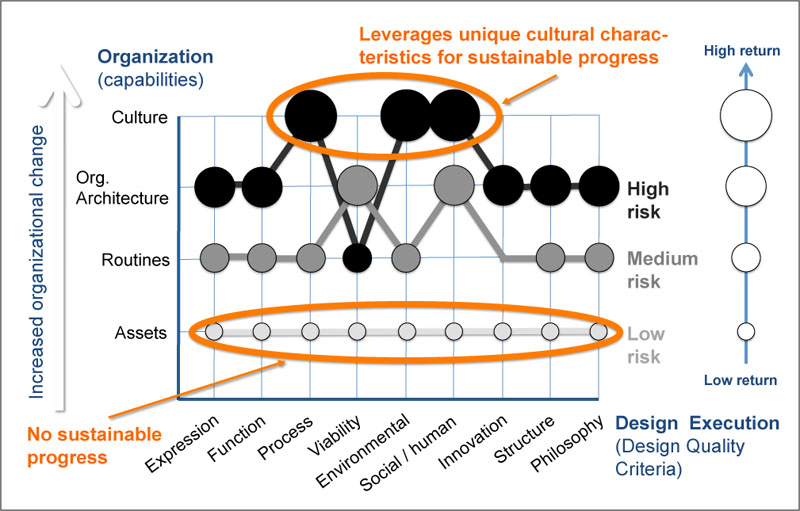
Mapping new product development execution, as characterized by actionable design quality criteria, to organizational capabilities (assets, routines, organizational architecture and culture) provides an overview over the challenging linkages and can help management match risk appetite and organizational renewal.
Purposely experimenting with new organizational designs through new ventures is a new paradigm for business. In an increasingly dynamic and complex global economy, consciously observing, designing, experimenting and learning can offer a strong alternative to traditional organizational and business model evolution.
Thinking of organizations in terms of design and innovation and not just fine-tuning or engaging in mergers and acquisitions, can provide new breakthrough ideas. Treating organizational renewal as an innovation process opens up new possibilities for what one's business can become, perform and accomplish.
Everyone from management to the design team traditionally sees their organization, strategy and it's business models as being more or less static. As a result, they rarely see a world in which new ventures and design projects provide increased revenues though a continuous steam incremental and breakthrough innovative offerings.
This restricted perception has unfortunate consequences for what is believed to be possible and even permissible, letting lucrative opportunities slip though their fingers. Think Xerox's window interface, Microsoft's browser and recently the entertainment industry's inability to see beyond producing and selling CDs.
What might be possible, if organizations, strategies and business models were thought of as malleable enablers of business opportunities as opposed to being restricted by rigid rules and procedures?
The transformation from new ventures existing in fixed systems, to new ventures living in flexible organizations, requires continuous mutual adjustments between the new venture and the organization. If the compatibly in culture, organizational architecture, routines diverge beyond the organization's ability to stretch, a separate new organization for the new venture may have to be put in place.
So, where do these opportunities for progress come from? Ideas regularly percolate up from new product development since high performing development teams, being closest to the action, live on the fringes of the organization and mingle with the vendors, users, competitors and regulators, while experienced competitors emerge, rise and retreat. Therefore, the designing of new ventures and the redesign of organizations will start here.
A natural next step is linking the development of new ventures and organizational renewal to the new product development process. Design of new products is the organization's lifeblood for securing a flow of ideas, knowledge, experience and innovative new products. This process defines what needs to happen and innovation is ultimately the mission of an organization in order to survive.
Using new product development as a vehicle and linking organizational capabilities to design execution, provides management with an overview to show which innovations require what level of organizational support and potential organizational renewal.
If the linkage between development and the organization is limited to assets allocation alone, the project provides no sustainably competitive advantage. On the other hand, if significant organizational cultural linkage exists and here, management support is essential, the project can then leverage an organization's unique cultural characteristics and will be difficult to imitate by competitors and thus will provide a sustainable competitive advantage.
Aligning organizational renewal with new product development is an innovative actionable strategy for continuously nurturing sustained progress. It effectively balances management's risk appetite for change with rewards for product innovation and ultimately for survival. Though innovation arises from new product development, management is the only one with the invaluable knowledge, authority and means to lead the renewal.